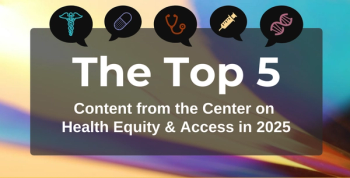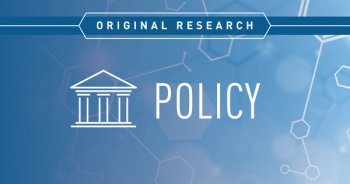
The American Journal of Managed Care
- May 2025
- Volume 31
- Issue 5
- Pages: 209-211
Managed Care Reflections: A Q&A With John Michael O’Brien, PharmD, MPH
To mark the 30th anniversary of The American Journal of Managed Care (AJMC), each issue in 2025 includes reflections from a thought leader on what has changed over the past 3 decades and what’s next for managed care. The May issue features a conversation with John Michael O’Brien, PharmD, MPH, a member of AJMC’s editorial board and the president and CEO of the National Pharmaceutical Council. This interview has been lightly edited for clarity.
Am J Manag Care. 2025;31(5):209-211.
AJMC: How have the concept of managed care and the conversations around it changed over the past 30 years?
O’BRIEN: Over my 30 years in health care, I’ve seen managed care go from being a derogatory term that referred to stinting on care to achieve PMPM [per-member per-month] savings to being a movement that embraced better health, better care, and lower total health care costs. But today, managed care is at an inflection point, and there are questions about the value that managed care plans provide against a backdrop that includes a dynamic policy environment and really important questions about the role of consolidation and vertical integration, cost-containment strategies, and the use of artificial intelligence. Additionally, as health care costs continue to go up, stakeholders like employers are starting to pay attention in ways that they weren’t 30 years ago.
Making sure the right patient gets the right care at the right time is still goal No. 1, whether we’re talking about accessing pharmacy benefits or medical benefits. But all too often, that’s not what patients describe that they’re experiencing. When you think about the drug side, patients are more likely to use a pharmacy more often than they are to see a physician or be admitted to a hospital, and that’s a good thing, but the pharmacy counter is oftentimes where patients experience delays, denials, or higher out-of-pocket costs, and that’s not good for patients. This is something we spend a lot of time thinking about here at NPC. We envision a world where advances in medicine are accessible to patients, valued by society, and sustainably reimbursed by payers to ensure continued innovation. Payers are and always should be concerned about the cost of care, but making sure we have an informed conversation about the bang for the buck that medicines deliver and how they help people get well, stay healthy, and avoid more costly care settings is really important to the future of managed care.
Today, we’re living in a golden age of biomedical innovation, and many of the medicines that are available today would have been considered science fiction when I was in pharmacy school 30 years ago. Back then, we didn’t have a pill to treat breast cancer or cure hepatitis C. We couldn’t have imagined long-acting injectables that prevent the transmission of HIV, let alone the promise of some of today’s cell and gene therapies. These treatments are tools that can help managed care plans achieve better population health and ultimately lower health care costs down the road. So we look forward to contributing to that conversation over the next 30 years by conducting research and publishing it in AJMC and other peer-reviewed journals and continuing to help managed care and the discussion around it evolve.
AJMC: What changes do you see taking place in managed care over the coming years?
O’BRIEN: Again, one of the biggest changes that I see taking place is that employers are getting a lot more engaged, and they should be, because they pay about half of the country’s health care benefits. They’re starting to ask really tough questions about whether their benefits consultants are steering them toward formularies that cost more money, and that’s part of a broader trend where they’re starting to ask for more value for money for both drugs and medical services. This is a direct result of the work that Shawn Gremminger and the National Alliance of Healthcare Purchaser Coalitions are leading. I think he and Mark Cuban, Greg Baker, Jonathan Levitt, they’re all leading a charge to help educate and bring more information to employers.
Managed care is going to have to adapt and find a way to create value for employers that doesn’t create unwanted friction for employees who are patients. There’s a real backlash right now against the restrictions that payers place between a patient, their provider, and the appropriate and needed treatment that’s best for them. For example, look at the co-pay accumulators and maximizers or alternative funding programs; our recent work highlighted the negative impact of these programs and other cost-shifting programs on patients.1 Also, the new restrictions that we’re seeing from payers on nononcology medicines via the accelerated approval pathway prevent patients with rare diseases or conditions that have no available treatments from accessing something that they’ve been waiting a long time for.2 Again, this isn’t good for patients, so this is why I’m hopeful about the focus that I see in President [Donald J.] Trump’s executive order about the value chain.3
There’s a need for policy makers and employers and others to have a better understanding of the way that prescription drugs help patients get well, stay healthy, and avoid more costly care settings, rather than looking at them simply as a source of margin extraction. When I first got started in this industry, we used to see drugs compete based on which one had the most efficacy at the lowest cost. The best drug at the lowest cost was the one that was on formulary. But that’s not how it works today, and I think this is obvious when you look at the preference that middlemen are placing on high-cost, high-rebate products. So again, I think the [increase in] questions that employers ask about how this is working or not working for them is the biggest change that I see in managed care right now.
AJMC: Over the years, you’ve written several pieces in AJMC about drug pricing and approval. What do you think are the most pressing questions around drug access that will be addressed in the policy decisions of this administration and the US Congress?
O’BRIEN: One of the things that I love most about being in policy and research, as opposed to politics, is that the evidence we generate with our research is useful to policy makers, regardless of who’s in office. Here’s what we know right now: President Trump just released an executive order that takes on issues that we’ve been focused on at NPC for some time, like investigating and fixing the pill penalty that exists within the Inflation Reduction Act Drug Price Negotiation Program, taking a good hard look at the 340B program and proposing some reforms to help patients, taking a look at the role of middlemen and their business practices, and otherwise improving transparency within the value chain.
Now, our research and the work of others has identified that the Inflation Reduction Act will delay launches, reduce the number of subsequent indications, and have a chilling effect on postapproval outcomes research.4,5 There are also a number of unanswered questions about whether or not patients will benefit from the Inflation Reduction Act’s effectuation, if you will, at the pharmacy counter. There’s uncertainty still about whether or how this law will actually disincentivize the development of small-molecule drugs or drugs with additional orphan designations to help patients living with rare diseases. On the 340B side, our research has identified that 340B is not a victimless crime that only takes money from pharmaceutical manufacturers. It’s costing employers, it’s costing states, and that’s ultimately costing patients. Our research found that costs for self-insured employers are actually going up $5 billion to $6 billion because of this program,6 and research from the National Alliance of Healthcare Purchasers looked outside drug costs and found that a 7.5% higher claims cost is actually costing employers a lot more in health care premiums.7 And when we think about pharmacy benefit managers [PBMs], their business practices are hurting patients, they’re not transparent, and these middlemen are keeping about half of what we call “drug spending” in the United States. So I do hope that policy makers take a good look at the evidence, fix the perverse incentives caused by the Inflation Reduction Act, address the way that the last administration interpreted the orphan drug exemption, pass meaningful PBM reform, and help restore the 340B program to its original intent and stop the explosive growth that’s increasing health care costs for self-insured employers. But most importantly, when it comes to policy, we need to remember that good policy-making begins with good evidence, and that’s something that we’re focused on and going to continue to do here at the NPC.
AJMC: How can the relationships between pharmaceutical makers, insurers, health systems, and patients be improved?
O’BRIEN: This question reminds me of Don Berwick quoting Paul Batalden in saying that “every system is perfectly designed to get the results it gets,”8 which means that we have some real work to do if we want a system that ensures that scientific advancement is accessible to patients, valued by society, and sustainably reimbursed by payers to ensure continued advancement. We can’t lose our world-leading ability to generate the next scientific breakthrough. We can’t lose our ability to turn a death sentence into a chronic, manageable condition, or generate a new cure that provides benefits that endure across a patient’s lifetime. When AJMC first launched 30 years ago, I was a pharmacy student making my first trip to Washington, DC, to better understand the role of health policy in patient care. Over those past 3 decades, I’ve relied on that experience to work across the government, to work in the managed care industry at a health plan, to work at a pharmaceutical company, and, most importantly, to care for my own parents as they’ve aged. It’s those experiences that inform my role today in leading the NPC. But the one thread that ties all of those experiences together is a never-ending belief that prescription medicines are something that help people get well, stay healthy, avoid more costly care settings, and live their best life the way that they define it.
But all too often, the way that we pay for medicines is about extracting margin today as opposed to generating value tomorrow. That’s true whether we’re talking about helping patients with enduring treatments across their lifespan or helping managed care plans achieve population health that lowers costs for years to come. We can’t pay for today’s treatments and tomorrow’s cures with the same reimbursement system that we used to pay for blood pressure medicines and cholesterol drugs decades ago. We need as much innovation in managed care reimbursement as we have in scientific innovation in the pharmaceutical labs. So here at NPC, we want to have an honest, evidence-driven conversation that helps decision makers, wherever they are, understand the value of scientific advancement, so that everyone understands how private-sector or government policies affect patient access to today’s treatments and tomorrow’s cures.
Congratulations on 30 years! We look forward to working with you over the next 30 as well.
REFERENCES
1. Westrich K, Buelt L, Narain A, O’Brien JM. Copay accumulator and maximizer programs: stakes rise for patients as federal rulemaking lags. Health Affairs Forefront. March 18, 2025. Accessed April 24, 2025.
2. Motyka J, O’Brien JM. Ongoing accelerated approval trends and what they mean for patients. National Pharmaceutical Council policy & evidence brief. January 27, 2025. Accessed April 30, 2025.
3. Steinzor P. Trump signs executive order to lower drug prices. AJMC. April 16, 2025. Accessed April 24, 2025.
4. Patterson J, Motyka J, O’Brien JM. Unintended consequences of the Inflation Reduction Act: clinical development toward subsequent indications. Am J Manag Care. 2024;30(2):82-86. doi:10.37765/ajmc.2024.89495
5. O’Brien JM, Motkya J, Patterson JA. How the IRA could delay pharmaceutical launches, reduce indications, and chill evidence generation. Health Affairs Forefront. November 3, 2023. Accessed April 30, 2025.
6. Sun C, Martin R, Zeng S, Motyka J, Campbell JD, Westrich K. The hidden costs of 340B to employers. Poster presented at: ISPOR Annual Meeting; May 5-8, 2024; Atlanta, GA. Accessed April 24, 2025.
7. New study reinforces impact of 340B Drug Pricing program on rising healthcare costs for employers – roughly $36 billion a year in extra hospital spending. News release. National Alliance of Healthcare Purchaser Coalitions. April 1, 2025. Accessed April 24, 2025.
8. Like magic? (“every system is perfectly designed…”). Institute for Healthcare Improvement. August 21, 2015. Accessed April 24, 2025.
Articles in this issue
Newsletter
Stay ahead of policy, cost, and value—subscribe to AJMC for expert insights at the intersection of clinical care and health economics.









































